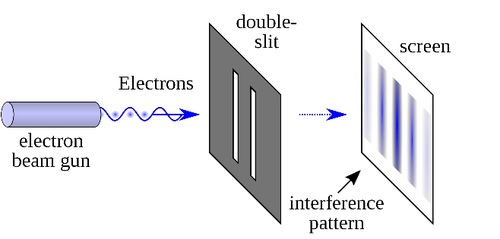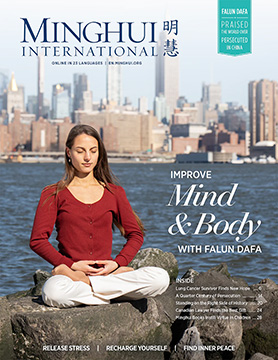(Minghui.org) Empirical science is based on materialism, which believes that matter is the fundamental substance and that mind cannot exist without material interactions. However, many discoveries in science, especially in the field of quantum mechanics, have indicated that mind may be one of the first-order realities that dictate matter.
Observer Effect: World of Uncertainty
The observer effect in quantum mechanics, namely, observing a quantum phenomenon can change the measured outcome of an experiment, has long challenged materialism. One example is the double-slit experiment which has confused great scientists including Albert Einstein and its “observer effect” which remains unexplained as of today.
British scientist Thomas Young conducted the first double-slit experiment in 1801. He had a beam of light passing through two parallel slits on a plate, behind which was a screen. The light wave passing through the slits split into two new waves, which then interfered with each other. When the peak of one light wave met the peak of the other wave, they reinforced each other, giving a brighter light. When the peak of one wave met the trough of another wave, they canceled each other out. As such, Young observed an interesting interference pattern – alternating bright and dark bands on the screen. Sir Isaac Newton thought that light consisted of particles only, and Young’s experiment demonstrated that light behaves more like a wave.
Later experiments of this type had atomic objects (electrons, protons, atoms, photons, and so on), instead of light, fired toward a double slit, and the alternating bright and dark bands were still observed. This result baffled scientists because these objects are all particles and should not have produced alternating bright and dark bands like light waves.
Some scientists believed that classical particles such as electrons also possessed characteristics of a wave so they interfered with each other (just like the light wave) in the experiments. In 1905, Einstein published several papers to discuss this effect. This brought him a Nobel Prize and laid the foundation for wave-particle duality in quantum mechanics, that is, what we consider “particles” possess characteristics of both particles and waves.
The duality characteristic was demonstrated in further experiments. More specifically, if electrons (or photons) were fired towards the slits one by one (so they had no chance to interfere with each other), would they strike the screen like classical particles or produce alternating bands? Numerous experiments showed the latter one – even a single electron would interfere with itself producing alternating bright and dark bands. But this is confusing: how could a single electron know where to go and end up generating alternating bands? Not only that, an electron seemed to cross both slits at the same time and merge on the other side to demonstrate the wave-particle duality.
More experiments were conducted. A metal detector was placed by the slits and the pattern on the screen then turned into the particle pattern of two strips (instead of alternating bright and dark bands). The interference pattern vanished, as if the particles knew they were being watched and chose not to be caught in the act of passing through the slits as a wave. This is dubbed the “observer effect” - observing a particle can dramatically change its behavior.
Quantum physics (studying the behavior of matter and light at the microscopic level on an atomic scale) was developed in part to understand the observer effect. Scientists such as Niels Bohr of Copenhagen Institute posited that quantum mechanics is intrinsically indeterministic, a view that is dubbed the Copenhagen interpretation.
Physicist Brian Greene wrote in his book The Hidden Reality, “The standard approach to quantum mechanics, developed by Bohr and his group, and called the Copenhagen interpretation in their honor, envisions that whenever you try to see a probability wave, the very act of observation thwarts your attempt.”
Erwin Schrödinger created the quantum wave function to define motion of all matter in the form of a series of probabilities. In other words, all physical quantities are considered to be in a series of quantum states with some probabilities. However, we don’t know which state physical quantities are in and the physical reality is split between all possibilities until an observation takes place.
Schrödinger demonstrated this with his thought experiment of Schrödinger’s cat. A hypothetical cat is placed in a hypothetical box and its fate is determined by a small flask of fatal hydrocyanic acid controlled by the quantum state of a subatomic particle. If the particle decays, the acid will kill the cat. If the particle does not decay, the acid will not be released and the cat will live. According to quantum mechanics, the status of the cat is always both alive and dead because the particle is in a state where it is both decayed and not-decayed. (note: this is different from not knowing the cat’s state due to lack of information). In reality, the cat’s fate is definitive, either alive or dead, once we open the box to observe it.
The thought experiment indicates that objects in the quantum world seem to be in an uncertain state until being intervened by an observer.
Quantum Entanglement
Because of the paradox in the thought experiment of Schrödinger’s cat (whose fate is not known until an observer opens the box according to quantum physics), Bohr and Einstein had numerous debates on this topic. They attracted wide attention because it was related to the fundamental understanding of the physical world.
After Max Planck discovered quantum (h), Einstein proposed light consisted of photons in 1905. Although Bohr opposed the theory, it was proven in 1922 and now widely accepted by the scientific community. As the uncertainty principle was introduced to quantum mechanics and slowly gained popularity, Einstein was worried because the randomness violated causality, the basic cause and effect relationship. We may not know how all the information of how things work, but there must be reasons behind these. “Quantum mechanics is certainly imposing. But an inner voice tells me that it is not yet the real thing,” Einstein wrote in 1926. “I, at any rate, am convinced that He [God] is not playing at dice.”
Nonetheless, most scientists accepted Bohr’s Copenhagen interpretation and the debates continued. In 1935, Einstein, Boris Podolsky and Nathan Rosen published a paper titled “Can Quantum-Mechanical Description of Physical Reality be Considered Complete?” They concluded that quantum mechanics’ description of physical reality using probabilities is incomplete. They asserted the concept of locality, meaning that physical processes (or events) occurring at one location should not instantly affect another event at a far away location. The locality concept seems intuitively correct, but quantum physics predicts that two subatomic particles can instantly affect each other even if they are light years apart. Einstein considered such an interaction inconceivable and dismissed it as “spooky action at a distance.”
In 1949, however, researchers at Columbia University showed a pair of particles could interact over a long distance. In 1998, physicist Nicolas Gisin and colleagues at the University of Geneva in Switzerland conducted an experiment and showed that two photons, 18 kilometers apart, could share information with each other at a speed at least 10,000 times faster than light speed. When one photon changed property, the same change happened to the other photo almost instantly, as if there was an imaginary being telling them both to make the change. How the interaction plays out remains a mystery.
Seeking Truth
Einstein did not give up seeking the truth despite the findings supporting quantum entanglement. From photoelectric effect to special relativity to general relativity, he wanted to help mankind understand the world. He showed that time is relative, and that gravity is caused by bending of time and space. Unsatisfied with the uncertainty at the heart of quantum mechanics, he worked on a project later known as his theory of everything, to extend general relativity and unite the known forces in the universe, wrote a BBC article titled “Einstein’s Unfinished Symphony.”
The article pointed out that, “Einstein’s work was underpinned by the idea that the laws of physics were an expression of the divine.”
“By completing this theory of everything Einstein hoped he would rid physics of the unpredictability at the heart of quantum mechanics and show that the world was predictable – described by beautiful, elegant mathematics. Just the way he believed God would make the universe,” wrote the article. “He would show that the way the quantum mechanics community interpreted the world was just plain wrong. It was a project that he would work on for the next 30 years, until the final day of his life.”
The work was never finished. When he was young, Einstein once said, “I am not interested in this phenomenon or that phenomenon. I want to know God's thoughts – the rest are mere details.” But it only remained a wish. “But as he lay there dying in Princeton Hospital he must have understood that these were secrets that God was clearly keen to hang on to,” continued the BBC article.
In May 1955, one month after his death, Life Magazine published an interview with Einstein conducted several months before. He said, “You know them to be true but you could spend a whole lifetime without being able to prove them. The mind can proceed only so far upon what it knows and can prove...There comes to a point where the mind takes a leap – call it intuition or what you will – and comes out upon a higher plane of knowledge, but can never prove how it got there. All great discoveries have involved such a leap”
Matter and Mind
Scientists’ efforts to understand mankind and the world continued in other fields related to quantum science. “Recent evidence for significant quantum coherence in warm biological systems, scale-free dynamics and end-of-life brain activity support the notion of a quantum basis for consciousness which could conceivably exist independent of biology in various scalar planes in spacetime geometry,” wrote Stuart Hameroff from the University of Arizona in the 2012 book of Exploring Frontiers of the Mind-Brain Relationship.
Besides Copenhagen interpretation, the double-slit experiment can also be explained by the many-worlds interpretation. Robert Lanza from Wake Forest University School of Medicine in North Carolina, said particles in quantum physics have undefined state because they exist in different universes simultaneously. When we die, our life becomes a “perennial flower that returns to bloom in the multiverse.”
“The world appears to be designed for life, not just at the microscopic scale of the atom, but at the level of the universe itself. Scientists have discovered that the universe has a long list of traits that make it appear as if everything it contains — from atoms to stars — was tailor-made just for us,” he wrote in Biocentrism: How Life and Consciousness are the Keys to Understanding the True Nature of the Universe, “the fact that the cosmos seems exactly balanced and designed for life is just an inescapable scientific observation—not an explanation for why.”
Higher Planes
According to Bible, God created the world. In Chinese culture, Pan Gu was said to have created the sky and earth, while Nuwa made human beings. These spiritual systems all reminded people of our connection with the divine and advised people to improve themselves and return to heaven.
Even in the modern era, there are various qigong systems, supernatural phenomenon, near-death experiences that connect people back to this tradition. The studies of matter of mind, as described above and those in psychology and sociology, also highlight the importance of positive behaviors including kindness. For example, a 50% increase of survival rate was observed among participants with strong social relationships according to a 2010 PLoS Med paper titled “Social relationships and mortality risk: a meta-analytic review.” Similarly, those who both gave support to others and received support from others had a lower risk of all-cause mortality than those who just received support, wrote a 2021Psychological and Cognitive Sciences article titled “The balance of giving versus receiving social support and all-cause mortality in a US national sample.”
All these are consistent with the ancient Chinese belief in the harmony of heaven, earth, and mankind. “When a person has righteous qi (energy) residing inside, no viciousness is able to invade,” wrote the classic Chinese medicine book Huangdi Neijing (The Inner Canon of the Yellow Emperor). This is consistent with the Chinese saying that “good is rewarded with good, and evil meets evil.”
A Wake-up Call
Although the Chinese Communist Party has nearly destroyed Chinese traditional culture since it took power in 1949, the thousands-year-long culture has nonetheless been revived and cherished by practitioners of Falun Dafa, a meditation system based on the principles of Truthfulness-Compassion-Forbearance.
Mr. Li Hongzhi, founder of Falun Dafa, recently wrote, “When a person dies it is just a matter of his physical body declining and breaking down, while his true soul (which is who he really is, and which does not die with the passing of his physical body) will continue on in a next life, being reborn.” (“How Humankind Came To Be”)
“If, in a trying setting like this, a person can still keep his thoughts virtuous; if he can hold his or her ground against the onslaught of modern values and views, and stick to traditional ones; and if he still believes in the divine in the face of assaults from the atheist and evolutionary camps, then that person will fulfill his purpose: to gain salvation and return to heaven,” he also wrote in this article.
From quantum mechanics to psychology, from ancient times to modern society, people have been searching for answers to who we are and where we are heading. Hope this article offers some insights.
Views expressed in this article represent the author's own opinions or understandings. All content published on this website are copyrighted by Minghui.org. Minghui will produce compilations of its online content regularly and on special occasions.









